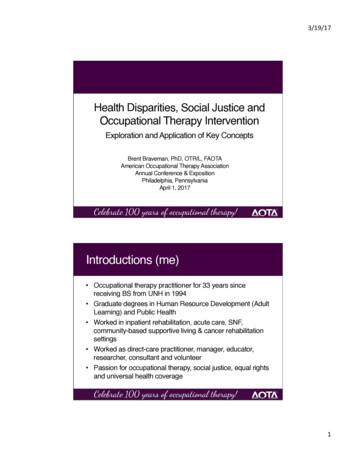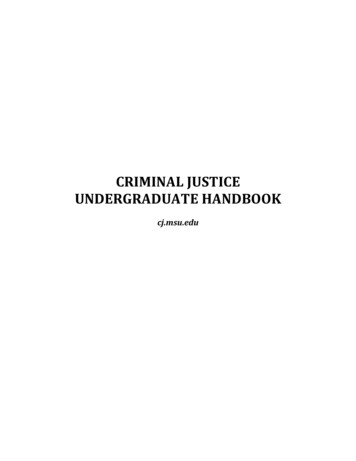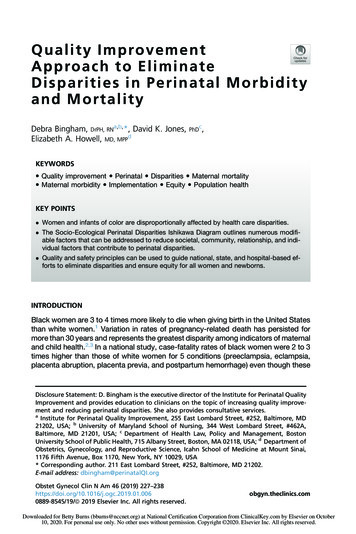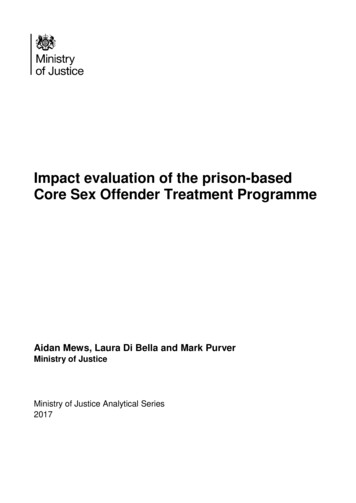
Transcription
3/19/17Health Disparities, Social Justice andOccupational Therapy InterventionExploration and Application of Key ConceptsBrent Braveman, PhD, OTR/L, FAOTAAmerican Occupational Therapy AssociationAnnual Conference & ExpositionPhiladelphia, PennsylvaniaApril 1, 2017Introductions (me) Occupational therapy practitioner for 33 years sincereceiving BS from UNH in 1994 Graduate degrees in Human Resource Development (AdultLearning) and Public Health Worked in inpatient rehabilitation, acute care, SNF,community-based supportive living & cancer rehabilitationsettings Worked as direct-care practitioner, manager, educator,researcher, consultant and volunteer Passion for occupational therapy, social justice, equal rightsand universal health coverage1
3/19/17Introductions (you)Who is in the audienceand why?Learning Objectives Define and describe the concepts of health disparities andsocial justice and explain their relevance for occupationaltherapy practice. Explain how various occupational therapy conceptualpractice models, AOTA official documents and globalperspectives on health disparities and social justice canguide occupational therapy intervention. Articulate a process and available resources thatoccupational therapy practitioners can use to self-assesstheir personal values and philosophical, ethical, economic,and political perspectives on health disparities and socialjustice.2
3/19/17Down a Rabbit Hole The occupation-health connection.3
3/19/17The occupation/health connection“Man, through the use of his handsas they are energized by mind andwill, can influence the state of hisown health” (Reilly, pg. 2, 1962).Reilly, M. (1962). OccupaIonal therapy can be one of the great ideas of 20th century medicine, 1961 Eleanor Clarke Slagle lecture.American Journal of OccupaIonal Therapy, 16, 1–9.The Occupation/Health Connection Occupations to meet the WHO prerequisites of health– Peace: seeking peaceful soluIons to disputes, supporIng displace people,providing help to the disadvantaged.– Shelter: building and customizing simple and complex living quarters and socialenvironments– EducaIon: aXending school, learning from community elders and religiouspracIces– Food: hunIng, gathering, farming, food retailing, serving and eaIng– Income: work, unpaid domesIc work– Stable ecosystem & sustainable resources: farming, water storage, protecInghabitats, urban planning– Social jusIce and equity: encouraging the occupaIonal potenIal of all people,supporIng group rights to maintain tradiIons or changing ways of doing ifthere is occupaIonal injusIce in terms of choice or opportunity.Wilcock, A. & Hocking, C. (2015). An OccupaIonal PerspecIve on Health. Thorofare, N.J: Slack4
3/19/17The Occupation/Health Connection Occupations to support physical health & well-being– A balance of work & recreaIon, balance of healthy diet & exercise,adequate sleep & rest, doing what you love Occupations to support mental health & well-being– EducaIon suited to abiliIes & needs, sImulaIng, saIsfying & enjoyableacIvity, able to meet individual interests and capaciIes Occupations to support social health & well-being– RelaIonships through occupaIon, shared purpose, social status throughoccupaIons, facilitaIve social and economic environmentsWilcock, A. & Hocking, C. (2015). An OccupaIonal PerspecIve on Health. Thorofare, N.J: SlackHealth Disparities5
3/19/17Health Disparities “Health disparities refer to population-specific differences in diseaserates, health outcomes, and access to health care services” (AOTA,2013). “A type of difference in health that is closely linked with social oreconomic disadvantage. Health disparities negatively affect groups ofpeople who have systematically experienced greater social or economicobstacles to health. These obstacles stem from characteristicshistorically linked to discrimination or exclusion such as race or ethnicity,religion, socioeconomic status, gender, mental health, sexualorientation, or geographic location. Other characteristics includecognitive, sensory, or physical disability” (U.S Department of Health andHuman Services, 2009). American Occupational Therapy Association. (2013). Occupational therapy in the promotion of health and well-being. American Journalof Occupational Therapy, 67(6, Suppl.), S47–S59. http://dx.doi.org/10. 5014/ajot.2013.67S47 U.S. Department of Health and Human Services, Healthy People 2020 Draft. 2009, U.S. Government Printing Office.Health Disparities Julie Bass-Haugen examined the evidence on U.S. healthdisparities with specific relevance to occupational therapy and byracial/ethnic groups and income levels. National survey data were used to identify variables related tooccupational performance or occupational therapy services thatshowed evidence of disparities. Data on U.S. citizens included health and behavioralcharacteristics, activity profiles, home and work environments,experiences in health systems, and outcomes of health careservices.Bass-Haugen, J. D. (2009). Health disparities: Examination of evidence relevant for occupational therapy. American Journal ofOccupational Therapy, 63, 24–34.6
3/19/17The “Unequal Treatment Report” “The health care environment contributes to disparities throughmany factors, including access, insurance, linguistic barriers, andcomplex bureaucracies. The clinical encounter itself is also acontributing factor. The report documented evidence from morethan 100 studies of enormous differences in quality of care fordifferent racial and ethnic groups for the leading clinicalconditions. It proposed that practitioners’ clinical uncertainty,beliefs or stereotypes, time pressure, limited or incompleteinformation, and high demand on attentional or cognitiveprocesses were contributing factors to care discrepancies inaddition to possible biases and prejudices” (Bass-Haugen, 2009,pg. 25).Bass-Haugen, J. D. (2009). Health disparities: Examination of evidence relevant for occupational therapy. American Journal ofOccupational Therapy, 63, 24–34.Health Disparities & the EnvironmentInterventions for the environment in four community clusters: built environments, as activity-promoting environments that providenutrition, transportation, housing, products, environmental quality, andappearance or ambiencesocial capital, factors that fulfill individual and group needs for socialcohesion and trust; collective efficacy; civic participation andengagement; and positive social, behavioral, and gender norms.services and institutions, provide access to medical and health care,public safety, education, and literacy.structural factors include ethnic and racial relations, economic capital,media marketing, community-based organizations, and cultural andartistic opportunities.Bass-Haugen, J. D. (2009). Health disparities: Examination of evidence relevant for occupational therapy. AmericanJournal of Occupational Therapy, 63, 24–34.7
3/19/17Health Disparities EvidenceRelevant for Occupational Therapy Adult citizens representing different racial/ethnic groups and incomelevels reported frequencies of negative emotions and challenges inperforming physical activities.Children from various racial/ethnic groups and income levels havedifferent activity profiles, living and school environments, healthcharacteristics and health care needs. Disparities in reported safety andsupportiveness of schools, neighborhoods and communities.Health care experiences were reportedly less positive for individuals andfamilies from non-White racial/ethnic groups and lower income levels.Outcomes of health care in nursing facilities and home health variedinconsistently by racial/ethnic group depending on the measure of healthstatus.Bass-Haugen, J. D. (2009). Health disparities: Examination of evidence relevant for occupational therapy. American Journal of OccupationalTherapy, 63, 24–34.AOTA’s Societal Statement onHealth Disparities (2013)“Occupational therapy practitioners have the responsibility tointervene with individuals and communities to limit the effectsof inequities that result in health disparities. Practitioners haveknowledge and skills in evaluating and intervening withindividuals and groups who face physical, social, emotional, orcultural challenges to participation. Further, the AmericanOccupational Therapy Association (AOTA) supports advocacyto increase access to health services for persons in need, andefforts to lessen or eliminate health disparities are consistentwith the Occupational Therapy Code of Ethics and EthicsStandards (2010) (AOTA, 2010).”Am J Occup Ther. 2013; 67(6 Supplement):S7-S8. doi: 10.5014/ajot.2013.67S78
3/19/17Social Determinants of HealthSocial Determinants of Health “A girl born today in Sierra Leone who survives to the age of5 is halfway through her predicted life span by the time shereaches age 17, whereas a girl born on the same day inJapan can expect to live into her 80s and will likely not diebefore she turns 5. This is the case because, unlike hercounterpart in Sierra Leone who faces an under-5 mortalityrate of 316 per 1,000 live births, the girl in Japan has only a5 in 1,000 probability of dying before she reaches her fifthbirthday (Marmot, 2005).”Marmot, M. 2005. Social determinants of health inequalities. Lancet 365(9464):1099-1104.9
3/19/17Social Determinants of Health “The conditions in which people are born, grow, work, live,and age, and the wider set of forces and systems shapingthe conditions of daily life” (World Health Organization,2015). Includes economic policies, development agendas, culturaland social norms, social policies, and political systems.World Health Organization. (2015). Social determinants of health. Online at: http://www.who.int/social determinants/enHealth Inequities “The unfair and avoidable differences in health between groups ofpeople within countries and between countries” stem from the socialdeterminants of health and result in stark differences in health andhealth outcomes” (World Health Organization, 2015).Variations in use of the terms “disparities” and “inequities” from onecountry to another– DispariIes ocen used in the US to denote racial or ethnic dispariIes involvingstructural racism and other forms of unjust discriminaIon that create gaps inhealth.– InequaliIes ocen used in the UK to describe differences among groups basedon socioeconomic condiIons.World Health Organization. (2015). Social determinants of health. Online at: http://www.who.int/social determinants/en10
3/19/17The moral importance of healthcare. The central moral importance for purposes of justice ofpreventing and treating disease and disability with effective healthcare services derives from the way in which protecting normalfunctioning contributes to protecting opportunity. Health care preserves for people the ability to participate in thepolitical, social, and economic life of their society. It sustains themas fully participating citizens. The relationship between health care and the protection ofopportunity suggests that the appropriate principle of distributivejustice for regulating the design of a health care system is aprinciple protecting equality of opportunity.Daniels, N. (2001). Justice, health, and healthcare. American Journal of Bioethics, 1(2), 2-16.Frameworks for Addressing theSocial Determinants of Health The Danaher Framework (contributions from the communitysector) World Health Organization Conceptual Framework Frieden framework for improving public health (potential impactversus labor intensity) Bay Area Regional Health Inequities Framework (link betweenhealth and social inequities) The Yoder Framework for dental education (service learning) Others focused on education, increasing access to healthNational Academies of Sciences, Engineering, and Medicine. (2016). A framework for educating health professionals to address thesocial determinants of health. National Academies Press.11
3/19/17Framework for OccupationalTherapy?Do we have a widely accepted framework thatconnects the values, underlying philosophiesand theoretical foundations of occupationaltherapy to efforts to address health disparities,inequities, social determinants of health andthe resulting injustice that disadvantagedindividuals and populations experience?Health Disparities Example: Cancer “The National Cancer Institute (NCI) defines "cancer health disparities"as adverse differences in cancer incidence (new cases), cancerprevalence (all existing cases), cancer death (mortality), cancersurvivorship, and burden of cancer or related health conditions that existamong specific population groups in the United States.” “These population groups may be characterized by age, disability,education, ethnicity, gender, geographic location, income, or race.People who are poor, lack health insurance, and are medicallyunderserved (have limited or no access to effective health care)—regardless of ethnic and racial background—often bear a greater burdenof disease than the general population.”National Cancer Institute. (2017). Cancer Health Disparities. Online rchd/cancer-health-disparities-fact-sheet#q112
3/19/17Health Disparities Example: Cancer “Complex and interrelated factors contribute to the observed disparitiesin cancer incidence and death among racial, ethnic, and underservedgroups. The most obvious factors are associated with a lack of healthcare coverage and low socioeconomic status (SES).”SES based on:––––IncomeEducaIon levelOccupaIonSocial statusNaIonal Cancer InsItute. (2017). Cancer Health DispariIes. Online hd/cancer-health-dispariIes-fact-sheet#q1Health Disparities Example: Cancer Studies have found that SES, more than race or ethnicity, predicts thelikelihood of an individual's or a group's access to education, certainoccupations, health insurance, and living conditions including conditionswhere exposure to environmental toxins is most common--all of which areassociated with the risk of developing and surviving cancer. SES, in particular, appears to play a major role in influencing the prevalenceof behavioral risk factors for cancer (for example, tobacco smoking, physicalinactivity, obesity, and excessive alcohol intake, and health status) as well asin following cancer screening recommendations. Research also shows that individuals from medically underservedpopulations are more likely to be diagnosed with late stage diseases thatmight have been treated more effectively or cured if diagnosed earlier.Financial, physical and cultural beliefs are also barriers that preventindividuals or groups from obtaining effective health care.National Cancer Institute. (2017). Cancer Health Disparities. Online rchd/cancer-health-disparities-fact-sheet#q113
3/19/17Health Disparities Example: CancerHealth Disparities Example: Cancer What factors might contribute to the disproportionateburden of prostate cancer among African American/Blackmen?– Changes in human DNA called variants are associated withrisk for prostate cancer– Nearly all the variants associated with increased risk ofdeveloping prostate cancer were found most ocen in AfricaAmerican/Black men leading to up to a five-fold increased riskof prostate cancer– And NaIonal Cancer InsItute. (2017). Cancer Health DispariIes. Online hd/cancer-health-dispariIes-fact-sheet#q114
3/19/17Health Disparities Example: Cancer In addition, research has shown that low SES, lack ofhealth insurance coverage, unequal access to health careservices, and absence of ties to a primary care physicianare barriers to screening for prostate cancer and the timelydiagnosis of this disease, making African American/Blackmen less likely to receive regular physical examination andscreening for prostate cancer.National Cancer Institute. (2017). Cancer Health Disparities. Online rchd/cancer-health-disparities-fact-sheet#q1Health Disparities Example: Cancer National Quality Forum Cancer 2015-2017 Endorse measures related to effective cancer treatment Part of endorsement process is examination of healthdisparities– Post breast conservaIon surgery irradiaIon (Moderate Gaps)– Percentage of female paIents, age 18-69, who have their first diagnosis ofbreast cancer (epithelial malignancy), at AJCC stage I, II, or III, receivingbreast conserving surgery who receive radiaIon therapy within 1 year (365days) of diagnosis.– Non-Hispanic White 92.1% Non-Hispanic Black 86.4% Hispanic 83.1%– Private insurance 91.7% Medicare 89.7% Medicaid/No insurance 86.1%15
3/19/17Social Justice and HealthThinking about Social Justice Defining social justice Is social justice a political construct/movement?– Is it by nature a progressive, liberal or democraIc ideal?– Is it parIsan? Does believing in social justice dictate a particularmeans to an end?– Can we agree that there is an injusIce or systemaIcdiscriminaIon but disagree about what should be done aboutit?16
3/19/17Defining Social Justice “Concept and practice of ensuring social equality” (Townsend, 1993).“Social justice is the view that everyone deserves equal economic,political and social rights and opportunities” (National Association ofSocial Workers, 2017)Braveman and Suarez-Balcazar (2009, p. 13) noted that “social justiceis a broad term that encompasses several interrelated concepts, suchas equality, empowerment, fairness in the relationship between peopleand the government, equal opportunity, and equal access to resourcesand goods.” Townsend, E. (1993). Occupational therapy's social vision. Canadian Journal of Occupational Therapy, 60(4), 174-184.National Association of Social Workers. (2017). Social justice. Online s/issue/peace.asp. Braveman, B., & Bass-Haugen, J. D. (2009). From the Desks of the Guest Editors—Social justice and health disparities: An evolvingdiscourse in occupational therapy research and intervention. American Journal of Occupational Therapy, 63, 7–12.Definitions of Social Justice/Distributive Justice Strict egalitarianism or radical equality such that everyperson should have the same level of material goods andservices (Stanford Encyclopedia of Philosophy, 2013). Distributive principles vary in what is considered relevant(income, wealth, opportunities, jobs etc.), in the recipients ofdistribution (individuals, groups, reference classes) and onwhat basis distribution should be made (equality,maximization, individual characteristics, free transactions) Stanford Encyclopedia of Philosophy. (2013). Distributive justice. Online ributive/#Strict17
3/19/17Health Disparities and Social Justice Health disparities may occur as a result of social injustice but arenot always primarily caused by injustice. “The concept of health equity focuses attention on the distributionof resources and other processes that drive a particular kind ofhealth inequality—that is, a systematic inequality in health (or inits social determinants) between more and less advantagedsocial groups, in other words, a health inequality that is unjust orunfair” (Braveman, P. 2014). Not all health disparities are unfair (e.g. genetic differences,differences driven by gender) As an occupational therapy practitioner are you taking action toaddress a health disparity, a social injustice, or both?John Rawls: The Difference PrincipleRawls proposes the following two principles of justice:1. Each person has an equal claim to a fully adequate scheme of equalbasic rights and liberties, which scheme is compatible with the samescheme for all; and in this scheme the equal political liberties, and onlythose liberties, are to be guaranteed their fair value.2. Social and economic inequalities are to satisfy two conditions: (a) Theyare to be attached to positions and offices open to all under conditionsof fair equality of opportunity; and (b), they are to be to the greatestbenefit of the least advantaged members of society. (Rawls 1993, pp.5–6.)Rawls, J. (1993). Political Liberalism, New York: Columbia University Press.18
3/19/17Distributive Justice: Practical Considerations(or avoiding the rabbit hole) “Partly because many writers on distributive justice tend to advocatetheir particular principles by describing or considering ideal societiesoperating under them, some readers may be misled to believe thatdiscussions of distributive justice are merely exercises in ideal theory.This is unfortunate because, in the end, distributive justice theory is apractical enterprise. It is important to acknowledge that there has neverbeen, and never will be, a purely libertarian society or Rawlsian society,or any society whose distribution conforms to one of the proposedprinciples, so rather than guiding ideal societies, distributive principlesprovide moral guidance for the choices that each society faces now andevery year” (Stanford Encyclopedia of Philosophy, 2013).Stanford Encyclopedia of Philosophy. (2013). Distributive justice. Online ributive/#StrictObjections to Social Justice“Orthodox libertarians stand on solid ground whenthey reject social justice. If the foundational principlesof libertarianism (self-ownership, say, or someprinciple of natural liberty) generate unassailablerights to property, then taxation of that property inpursuit of the distributional requirements of socialjustice is unjust” (Tomasi, 2012, p. 123).Tomasi, J. (2012). Free Market Fairness. Princeton, N.J.: University of Princeton Press.19
3/19/17Objections to Social Justice Objection to the assumption there should be adistributive pattern (benefiting the leastadvantaged). The market will be just, not as a means to somepattern but because acquisitions or exchanges arejust in their own right. Just outcomes are arrived at by the separate justactions of individuals.Stanford Encyclopedia of Philosophy. (2013). Distributive justice. Online ributive/#StrictSocial Justicitis-Free Market Fairness “A strongly negative, even allergic reaction to the ideal ofsocial or distributive justice” (Tomasi, 2012, p. 124). Difference principle-social and economic inequalities shouldbe arranged so that they are to the greatest benefit to theleast advantaged. Fair equality of opportunity-differences of talent, station andambition are ineliminable facts of the human existence andare acceptable so long as those inequalities improve theopportunities of the least fortunate.Tomasi, J. (2012). Free Market Fairness. Princeton, N.J.: University of Princeton Press.20
3/19/17Rights, Health and OccupationalOpportunityRights Categories of rights– Who is alleged to have the right (e.g. children’s rights,workers’ rights)– What acIons or states or objects the right pertains to (e.g. tofree expression, property rights, rights of privacy)– Why the rightholder (allegedly) has the right (e.g. moral rightsgrounded in moral reasons, legal rights derived from the law)– How the asserted right can be affected by the rightholder’sacIons (e.g. inalienable right to life, forfeitable right to liberty,waivable right that a promise be kept).Stanford Encyclopedia of Philosophy. (2015). Rights. Online at: hXps://plato.stanford.edu/entries/rights/#2.1.21
3/19/17Human Rights“Human rights are rights inherent to all humanbeings, whatever our nationality, place of residence,sex, national or ethnic origin, colour, religion,language, or any other status. We are all equallyentitled to our human rights without discrimination.These rights are all interrelated, interdependent andindivisible.”United Nations Office of the High Commissioner. (2017). Human Rights. Online at: ights.aspxUnited Nations Declaration ofHuman Rights Declared and adopted by the United Nations GeneralAssembly in 1948. Comprised of 30 articles addressing rights such as:– Life, liberty and security of person– Slavery, inhuman, degrading punishment– Equal protecIon before the law, effecIve remedy, and publichearing of criminal charges– Freedom of movement within one’s country– Marriage, family and dissoluIon– Right to own property and not to be arbitrarily deprived of property– Freedom of thought, conscience and religionUnited Nations. (2015). Universal declaration of human rights. Online at:http://www.un.org/en/udhrbook/pdf/udhr booklet en web.pdf.22
3/19/17United Nations Declaration ofHuman RightsFreedom of expressionPeaceful assembly and associaIonRight to work and to equal payRight to rest and leisurea standard of living adequate for the health and well-being ofhimself and of his family, including food, clothing, housingand medical care and necessary social services, and the rightto security in the event of unemployment, sickness, disability,widowhood, old age or other lack of livelihood incircumstances beyond his control.– Right to educaIon–––––United Nations. (2015). Universal declaration of human rights. Online at:http://www.un.org/en/udhrbook/pdf/udhr booklet en web.pdf.WFOT Statement on Human RightsPrinciples “People have the right to participate in a range of occupations thatenable them to flourish, fulfill their potential and experience satisfactionin a way consistent with their culture and beliefsPeople have the right to be supported to participate in occupation and,through engaging in occupation, to be included and valued as membersof their family, community and societyPeople have the right to choose for themselves: to be free of pressure,force, or coercion; in participating in occupations that may threatensafety, survival or health and those occupations that are dehumanising,degrading or illegal.The right to occupation encompasses civic, educative, productive,social, creative, spiritual and restorative occupations. The expression ofthe human right to occupation will take different forms in different places,because occupations are shaped by their cultural, societal andgeographic context.”World Federation of Occupational Therapists. (2006). Statement on Human Rights. Online at:http://www.wfot.org/ResourceCentre.aspx.23
3/19/17WFOT Statement on Human RightsPrinciples Continued: At a societal level, the human right to occupation isunderpinned by the valuing of each person’s diversecontribution to the valued and meaningful occupations ofthe society, and is ensured by equitable access toparticipation in occupation, regardless of difference Abuses of the right to occupation may take the form ofeconomic, social or physical exclusion, through attitudinalor physical barriers, or through control of access tonecessary knowledge, skills, resources, or venues whereoccupation takes place.”World Federation of Occupational Therapists. (2006). Statement on Human Rights. Online at:http://www.wfot.org/ResourceCentre.aspx.WFOT Statement on Human RightsChallenges for Occupational Therapists and Occupational Therapy Associationslie in the following areas: Accepting professional responsibility to identify and address occupationalinjustices and limit the impact of such injustices experienced by individuals Raising collective awareness of the broader view of occupation andparticipation in society as a rightLearning to work collaboratively with individuals, organisations, communitiesand societies, to promote participation through meaningful occupation Teaching and developing universal design, thereby promoting a society thatis truly accessible to all Responsibly addressing the issue of cultural sensitivity, and fostering culturalcompetencyWorld Federation of Occupational Therapists. (2006). Statement on Human Rights. Online at: http://www.wfot.org/ResourceCentre.aspx.24
3/19/17WFOT Statement on Human RightsWorld FederaIon of OccupaIonal Therapists. (2006). Statement on Human Rights. Online at:hXp://www.wfot.org/ResourceCentre.aspx.All this is great, but what does it haveto do with occupational therapy?25
3/19/17But is that occupational therapy? “As a profession, occupational therapy has moved beyondthe question “Is that occupational therapy?” to the equallyimportant questions of “Is that something that occupationaltherapy practitioners can do?” “Can occupational therapymake an important contribution in this area?” and “How canwe demonstrate our distinct value through contributions topopulation health” (Braveman, 2015, pg. 4)?Braveman, B. (2015). Population health and occupational therapy. American Journal of Occupational Therapy, December 2015,Vol. 70, 7001090010p1-7001090010p6. doi:10.5014/ajot.2016.701002But is that occupational therapy?AcIonPracIceTherapy26
3/19/17Layers of interventions byoccupational therapy practitioners Occupational therapy is the therapeutic use of everydaylife activities (occupations) with individuals or groups forthe purpose of enhancing or enabling participation in roles,habits, and routines in home, school, workplace,community, and other settings.– Direct service to an individual with cancer in a culturally andliteracy appropriate manner to accommodate for limitaIonsin wriXen and spoken EnglishLayers of interventions byoccupational therapy practitioners Occupational therapy practice is the provision of servicesprovided for habilitation, rehabilitation, and promotion ofhealth and wellness for clients with disability- and nondisability-related needs.– ConsulIng with a community-based agency serving lowincome families on strategies to promote healthy behaviorsincluding finding, purchasing and eaIng fresh fruits andvegetable and engaging in exercise and social occupaIons ina safe environment.27
3/19/17Layers of interventions byoccupational therapy practitioners Occupational therapy action includes steps you may take toaddress health disparities
Occupational Therapy Intervention Exploration and Application of Key Concepts Brent Braveman, PhD, OTR/L, FAOTA American Occupational Therapy Association Annual Conference & Exposition Philadelphia, Pennsylvania April 1, 2017 Introductions (me) Occupational therapy prac










